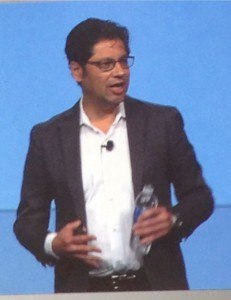RMS launched its Exceedance 2014 conference in Washington, D.C. on April 14 with a hard sell of RMS(one), a cloud-based catastrophe risk management system the California company hopes will modernize and transform the industry. The hype was interspersed, however, with some sobering doses of reality.

(Photo by Mark Hollmer)
RMS is not without obstacles in the months ahead, including an acknowledgment that executives recently delayed a full production rollout for RMS(one) until fall, in part to iron out further kinks.
RMS co-founder and CEO Hemant Shah said as much as he made his entrance onto a giant stage to polite applause and formally launched the conference. (His debut followed a buildup of rock and club music, as well as a high-tech video production that walked the audience through the history of catastrophe modeling.)
Shah noted RMS(one)’s profound development progress in increasing speed, reliability and security of the data it generates and can house. At the same time, Shah—dressed in a crisp white shirt, dark suit and stylish black glasses— acknowledged shortcomings along with the hype.
“We also know we have a lot more to do,” he admitted to an audience of about 800 people. Shah said a delay in the full production availability of RMS(one) until the fall will help continue to reduce bugs, boost efficiency and give clients time to translate catastrophe models to the new system in order to give them the level of functionality that they desire.
An RMS spokesperson explained to Carrier Management that the “amended schedule for RMS(one) was shared at the end of March.” The spokesperson reiterated that in the interim, “we are introducing an on-ramping period where clients will be able to work in RMS(one) in a pre-production environment—where they will be able to integrate RMS(one) with their existing systems, upload historical data and train staff. In Autumn 2014, our clients can switch into production mode.”
To compensate for this, clients will pay a fixed rate during the “on-ramping” period that costs less than the usage-based pricing structure RMS(one) will use when it is fully launched, the spokesperson said.
Shah, in his morning remarks, pointed out that RMS completed a final “beta window” just a week ago, after which “feedback was quite spirited,” constructive and actionable. He said RMS has been “responding on faster and faster cycles” ever since. The company has resolved “key infrastructure” issues, its data centers continue to keep “gaining experience and maturity” in handling the operations, and software engineers have successfully tweaked RMS(one) to give clients a “snappier user experience,” Shah said.
And then the hype returned. Shah said that “it is time for innovation, and I believe that the industry is ripe for positive change.” With that in mind, he argued that RMS(one) “will democratize liquidity of information,” expand choice for catastrophe modeling options and also increase capacity of how much clients can do with risk management.
As RMS(one)’s developers explained in a stylish video mini-documentary shown in between speakers, the system is designed to accomplish a lot at once, including a look at exposures, results and catastrophe models. If it works successfully, it will handle multiple views of risk, and the added computing power from private cloud data centers in California, Iceland, Toronto and London should help users produce catastrophe models with greater granularity and accuracy and quicker results, they said.
RMS(one) will also enable open modeling, a novelty for the industry that will let clients control, customize and shape their own models.
Perhaps in an acknowledgement of the cautious and conservative nature of the property/casualty insurance industry, Shah assured his audience that they will not be forced into using RMS(one). They can keep relying on the older RMS RiskLink modeling platform “through the foreseeable future, with software updates through 2016,” he said.
“You are in control to explore and use RMS(one) in the time frame you are comfortable with,” Shah said.
That attitude could come in handy in the months ahead. Before the general session that launched the conference at the Gaylord National Resort & Convention Center, attendees gathered for a networking breakfast. One modeling expert told Carrier Management that some are very cautious about switching to RMS(one) because of reticence about security, the technology and changing a system that already seems to work well enough as it is.





















 Nearly Half of 100 Largest P/C Insurers Destroy Value: ACORD
Nearly Half of 100 Largest P/C Insurers Destroy Value: ACORD  Rebuilding Negotiation Talent: Why This Skill Is Missing and How to Fix It
Rebuilding Negotiation Talent: Why This Skill Is Missing and How to Fix It  Northern California Flooding This Weekend Caused by Heavy Rain, High Tides
Northern California Flooding This Weekend Caused by Heavy Rain, High Tides  Is the AI Boom a Bubble Waiting to Pop? Here’s What History Says
Is the AI Boom a Bubble Waiting to Pop? Here’s What History Says 










